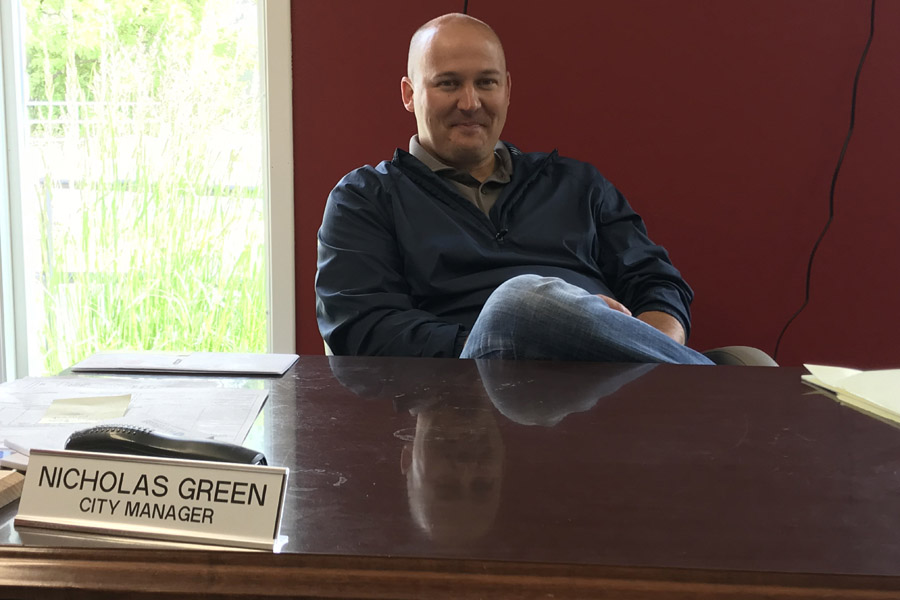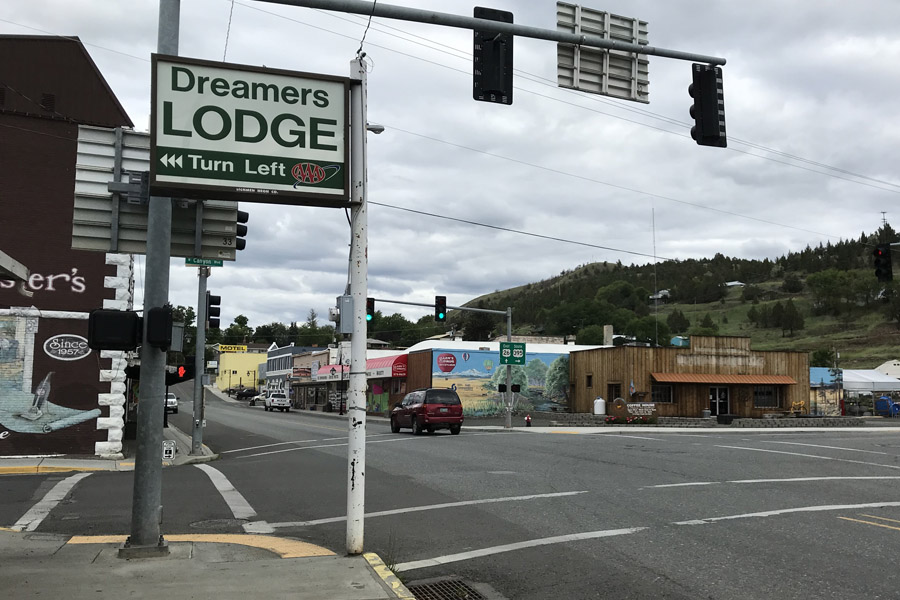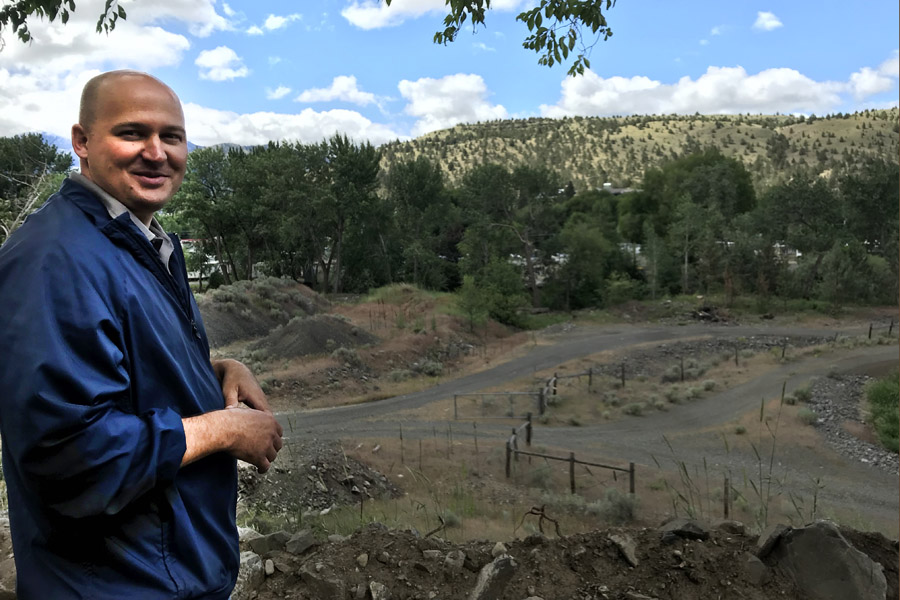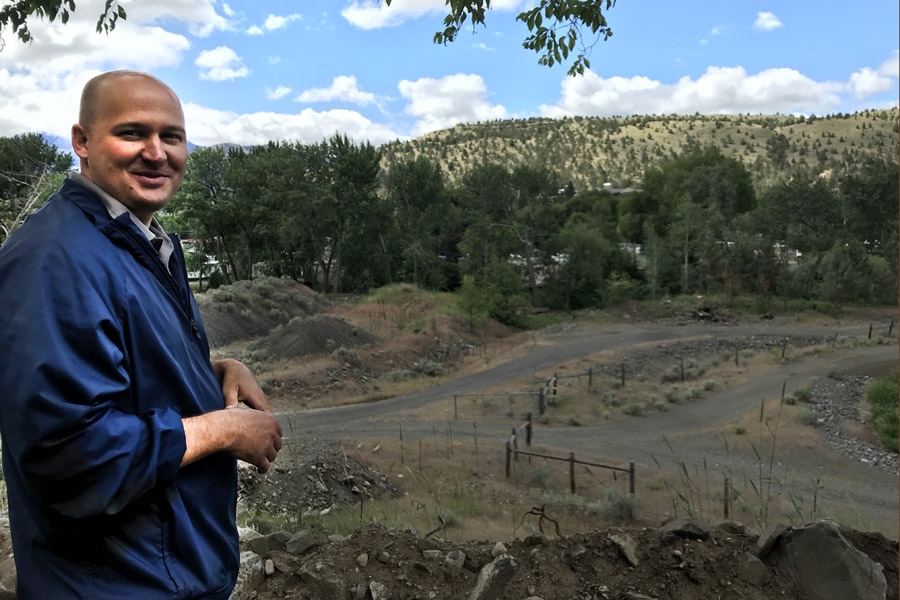John Day’s city manager envisions a sustainable, high desert city.
On the western approach to the rural city of John Day, the stunning yellow and red hued high desert landscape of eastern Oregon gives way to a scene of economic blight. The hull of a disused timber mill flanks the left side of the highway. A couple of empty storefronts line John Day’s main street, which sports the city’s sole traffic light.
For a town close to one of state tourism agency’s 7 Wonders of Oregon — the Painted Hills, part of John Day Fossil Beds National Monument — John Day, pop. 1,674, doesn’t have much to offer tourists that come from all over the world to visit the geological phenomenon. There are few good quality hotels, and the John Day River, which runs directly through town, is hidden behind a wire fence and residents’ backyards.
All this is about to change if Nick Green, the new city manager, gets his way.

Hired in 2016, Green, a former management consultant, has a plan to transform John Day, the largest city in Grant County, into a center of excellence for agricultural innovation and eco-tourism. His vision revolves around an “innovation gateway,” located on 80 acres of public land, which will encompass hydroponic greenhouses, botanical gardens, an academic campus for agricultural research, and miles of riverfront hiking trails.
It is the kind of ambitious plan that rural city governments are often slow to implement. But Green, with his background in the private sector, says he will not be restricted by red tape. He wants to run John Day like it is a business.
“I loathe the perception of government that it is slow and inefficient. That is not the way I want to run a city,” says Green. “We are not doing any of the conventional things a government is known for. We have got the core infrastructure and services we provide, but I tell people, ‘this is not your granddaddy’s government.’ We are trying to do things that are new and innovative.”
A native of Salt Lake City, Green spent much of his career working for technology consulting firm Booz Allen Hamilton in Washington D.C. Although this is his first public sector job, he has plenty of experience dealing with government.
At Booz Allen, Green oversaw the deployment of technology in support of troops for Operation Iraqi Freedom. He worked with private sector companies to find technologies required by soldiers in the field; anything from biometrics capabilities for identifying insurgents to improvised explosive device detection systems.
Green says he learned how to work within the established bureaucracy and get things done. “It thrust me out to the tip of the spear from a technology acquisition standpoint,” he says.
“We had to throw the old rulebook out. The old rulebook said it will take 10 years to evaluate a technology before you put it into the hands of a soldier. We didn’t have ten years; we didn’t have ten months.”
 One-and-a-half miles of hiking trails are planned for development
One-and-a-half miles of hiking trails are planned for development
After several years working in consulting, Green was ready for a change. He wanted a career integrating public policy and technology with his fascination for rural communities and their challenges. “They have such a high quality of life, but they are so economically depressed and facing a lot of problems with migration and ageing population and infrastructure.”
Green had just graduated from the University of Washington with a Masters in Public Administration when he took the position of city manager. John Day is also his wife’s hometown. “Our family is here so this is coming home for us.”
The economic problems in John Day and the surrounding towns of Grant County run deep. A community once reliant on timber for its revenue base, it has struggled to adapt to economic change. Grant County has the highest unemployment rate in Oregon (6.8%, 2017); the state’s second lowest median household income ($35,974, 2010 census); and the second lowest real market property values.
RELATED STORY: REBRANDING KLAMATH COUNTY
It also has the third highest rate of population decline. John Day’s population, which peaked in the 1990s, is now at the same level it was in the 1970s.
All but one of the four timber mills in the valley between John Day and Prairie City, a town nearby, are closed. Agriculture, forestry, and public-sector jobs are now the mainstays of the local economy.
To some extent the county’s problems lie in an attitude that once flourishing industries, like timber, will recover. It is a view that is misguided, says Green. “We are not trying to reinvent John Day or eastern Oregon. But it feels a little bit like that because we have lost our economic base. There are a lot of people who are waiting for that to come back. They think natural resources will come back; timber will come back; that we just need a number of consecutive Republican administrations and that will solve the problem. It won’t.”
The answer to economic recovery in rural Oregon lies in new sectors with high-growth potential, such as ecotourism and agritourism, says Green. Although there are pockets in the county where farmers and ranchers have tried to rebrand themselves as destination locations for tourists, governments have failed to do enough to develop this area of the new economy, he says.
“As public agencies we have not made a concerted effort to attract and sustain those types of visitors. It is evident from the lack of investment in new hotels and some of our ageing infrastructure.”
RELATED STORY: IS OREGON GOOD FOR BUSINESS?
Rural economic development experts point to high-growth sectors, such as agritourism, as a sustaining force for rural communities. Agritourism can generate more revenue for rural residents than conventional tourism because it allows them in a direct way to diversify their income. Examples include ranches that allow visitors to help drive cattle, or farms that do livestock tours.
Anne Mitchell, economic vitality program manager at Rural Development Initiatives, says agritourism has grown in popularity as tourists increasingly become interested in finding out more about where their food comes from and connecting to the land.
Mitchell welcomes Green’s plan for diversifying the economy. “It is innovative. It integrates technology, education, infrastructure and training centers. It is the kind of thing rural communities need to do to stay relevant and move forward into the future.”
Surprisingly, the source of technological innovation planned for the city originates from its need for a new waste water treatment plant. The current outdated facility, built in 1947 and located next to the John Day River on 30 acres of public land, has operated without a permit from the Department of Environmental Quality for several years.
Construction on the new plant, which will be on one acre of land instead of thirty, is scheduled to begin in 2019 at a projected cost of $8-10 million. Funding comes from a variety of federal and state sources, including the USDA Rural Development agency and Business Oregon.
Bucking the trend for conventional use of public infrastructure, Green has planned for a state-of-the-art facility that will reclaim up to 80 million gallons of water a year. This reclaimed water will be used to grow commercial crops in a new 6,000 sq. ft. hydroponic greenhouse.
The greenhouse is estimated to produce 30 tons of produce a year. Specialty crops are also planned, such as hops, which can grow year-round in a greenhouse; and hemp, which can be processed into textiles and lotions.
Nick Green describes his plans for a new open air market selling locally grown produce
The fresh produce from the greenhouse will be a big economic asset in a rural community known for being a food desert, says Green. “Almost all the food we consume is imported from California or Canada. To be able to grow our own produce and grow in excess and be able to export to regional markets is a real opportunity.”
The greenhouse will be open to tourists, who can tour the facility and learn about water reclamation technology. Profits from the venture will accrue to the waste water treatment facility to drive down utility bills.
Adjoining the 30 acres of public land planned for development is a 53-acre plot formerly owned by DR Johnson Lumber Company. This is the site of the former mill property, Oregon Pine, which has been a brownfield site for more than a decade. Green negotiated to buy the property from DR Johnson in 2017 for $519,000. The purchase gives the city 80 acres of riverfront and highway frontage property to develop on.
 Oregon Pine disused timber mill planned for redevelopment, John Day
Oregon Pine disused timber mill planned for redevelopment, John Day
You have to squint to picture the land, still undeveloped with the unsightly waste water treatment plant at one end and the husks of long-disused timber mill structures at the other, eventually containing hiking trails, public gardens and lively commerce. But the property is in a beautiful spot with snow-capped mountains in the distance and the extraordinary beauty of the high desert for miles around.
This fall, developers will open up a mile-and-a-half of riverfront trail. For the first time in decades, the John Day River, never a central feature of land use planning, will finally be accessible to the public.
The trail system “is definitely needed to enhance livability here,” says Allison Field, economic development specialist for Grant County. She adds the riverfront development will benefit local outdoor recreational businesses, such as Wildcat Basin Outfitters, which is due to open a store in John Day this summer.
“We do get a lot of tourists. Cycle Oregon comes through, the eclipse. If we could have more things like that it would be great for tourists and local residents,” says Field.
 Main street, John Day
Main street, John Day
With 80 acres of land at the city’s disposal, Green sees opportunity to build an academic-style campus focused on rural and agricultural research and workforce training. He has reached out to Oregon State University, which has an extension office in John Day, and Eastern Oregon University, about possible partnerships. Areas of research he sees suited to the local culture and demographics include controlled environment agriculture, riparian restoration and watershed research.
An ambitious long-term proposal is to create a botanical garden on the site, similar to the Oregon Garden in Silverton. It may seem counterintuitive to have a botanical garden in the middle of the high desert. But John Day has more than ample supply of water with the planned 80 million gallons of reclaimed water from its new waste water treatment plant. The Oregon Garden uses reclaimed water from the City of Silverton to irrigate its 80 acres of gardens.
Green’s undergraduate degree in microbiology spurred his thinking of using reclaimed water for irrigation. “We view this as rural innovation,” he says. “Using the science of reclaimed water in conjunction with high growth industries and things that promote destination tourism.”
RELATED STORY: IN RURAL OREGON, BOOKSTORES UNITE COMMUNITIES IN TRANSITION
The entire cost of the project is an estimated $20 million. The city will have the $8-10 million in the bank for the construction of the waste water treatment plant this year. Apart from federal and state funding for the facility, the city is looking at private funding from the municipal bond market.
The rest of the planned development will depend on when funds become available.
“We will move money and do development as we can. But our hope is that as industry comes back we will have more tax revenue to pursue that.”
 The site of John Day’s innovation gateway
The site of John Day’s innovation gateway
A big part of Green’s job is fundraising, but it can be hard to get private investors to commit at this early stage. He would like a hotel group to build a resort hotel on the property. He also envisions a private enterprise running a brewery/restaurant and businesses operating a year-round public market selling locally grown produce and aquaculture.
No funds exist yet for a botanical garden. Green is working with some nonprofit endowments to spur interest.
Losing fundraising momentum worries him, he admits.
If investors do not come forward, the city is ready to fund the ventures with public money or enter public/private partnerships. “We are prepared to do this ourselves. We realize we can’t remain in population decline and still be viable. These have to be municipal enterprises that create jobs and growth until we attract the private sector.”
The need to boost tax revenues has spurred an ambitious new housing incentive program that encourages new residential home construction and home remodeling. The goal is to have 100 new homes built in the next 20 years, about a 12-15% increase in the existing housing stock.
RELATED STORY: A RURAL CITY’S AGGRESSIVE PUSH FOR MORE HOUSING
It is a lot change for a conservative rural community. Local reaction to Green’s proposals has been mixed.
Residents like the idea of lower utility bills and business owners want more customers, says Green. But locals worry about change. “When you talk about growth they worry that it will become Bend,” he says.
City officials have reassured residents the growth plan envisions the addition of 300 to 500 people, not the phenomenal growth seen in Bend, where the population has grown more than 70% since 2000.
“People want to maintain their quality of life. They want to maintain their rural values.” But he defends his ideas, emphasizing they are a good fit for the local community.
“The conservative rural values are consistent with what we are trying to do. We are trying to keep what is great about our community and enhance it. We are not trying to replace it.”
A version of this article appears in the July/August issue of Oregon Business.







